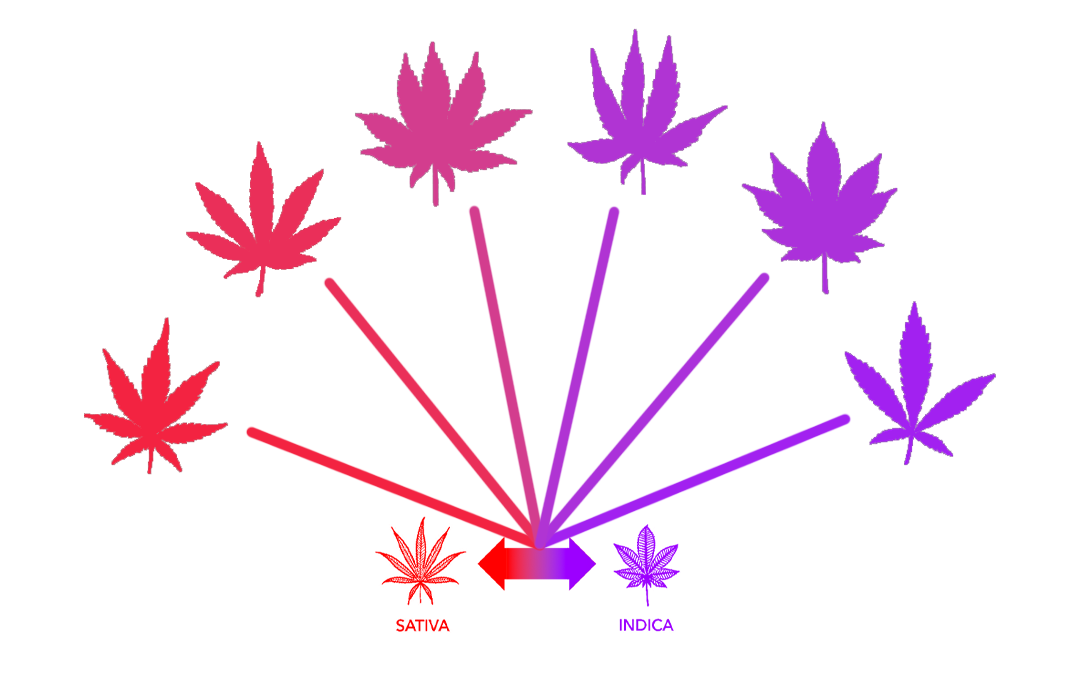Indica, Sativa, and Hybrid
Do words like Indica, Sativa, and hybrid matter when you’re shopping for cannabis? What about terpenes? We’re breaking it all down so you can be better informed when deciding which cannabis products to purchase at a dispensary.
As a consumer, you may have noticed that some product packaging in cannabis dispensaries no longer uses the words “Indica” or “Sativa” on it, instead showing strain genetics and terpene information.
Why is that? As it turns out, the whole “Indica/Sativa” thing isn’t always helpful when it comes to determining a strain’s smell, taste, and effect. While it’s true that there are some differences between so-called “Indica” and “Sativa” strains, these days they’re negligible due to all the hybridization that’s been done with cannabis over the years. Indica and Sativa classification actually plays a very small role in determining how a certain strain may affect you personally.
Where the Terms “Sativa” and “Indica” Originated
Indica. Sativa. Hybrid. Chances are you’ve come to know these terms pretty well if you’re a seasoned cannabis consumer. If not, you may find yourself wondering: what’s the difference? How do I know for sure how a product is going to make me feel?
To answer these questions, let’s hop back in time to the early 1800s when French biologist Jean-Baptiste Lamarck classified cannabis into two subspecies: Cannabis Sativa and Cannabis Indica. Because Sativa was typically taller and had longer leaves than Indica, Lamarck believed they were two separate plant species. Lamark hypothesized that because of the two plant’s differing physical traits, they had different uses and effects.
Over time, botanists and other cannabis researchers like Jeff Chen, Director of the UCLA Cannabis Research Initiative, have been able to poke holes in Lamarck’s theory when studying the molecular structure of these plants. Chen and many others now believe that there is only one species, Cannabis Sativa L. The differences presented in the plants were actually due to the natural landscape and environment in which the plants were grown; this also causes the differing effects that various strains (or cultivars) provide.
Research suggests that factors such as temperature, sunlight, nutrients, humidity, and altitude can all impact how a person is affected by a particular strain – and this is without even accounting for each person’s unique Endocannabinoid System. For example, OG Kush grown somewhere like Colorado is likely going to give a different taste, smell, and effect than OG Kush grown in states like Washington or Oregon.
The reason for this is partially caused by terpenes—aromatic molecules produced by all plants. However, in cannabis plants, terpenes impact smell and taste, as well as the effects you experience when consuming it.
How to use Terpenes to Find Smell, Taste, and Effect
Research has shown that terpenes not only provide the taste and smell of a cannabis cultivar, they also determine the effect various strains can have on you. For example, Myrcene is the most commonly found terpene in cannabis and smells/tastes a bit peppery, earthy, and slightly sweet while providing an effect that promotes relaxation, mood enhancement, and has even been shown to help reduce inflammation in the body.
While it’s becoming more common, it can still be difficult for customers to find products that list their terpene breakdown. But when you choose Passion Flower products, you can see how we are helping to improve education for our consumers! Not only do we provide terpene information on every package, but we also include a sliding scale to show whether the effect is known to give a more relaxed or awake feeling. You can learn more about the educational tools we provide on our packaging here! We do this to help consumers learn and remember which terpenes work best for their body’s personal needs – and find other products that include the terpenes they favor most.
Conclusion: Does Indica VS. Sativa Matter?
At its simplest, not really.
While the majority of strains that provide a more “Indica” or relaxed feeling are rich in terpenes in line with that effect (vice versa for “Sativa” strains) we also want to note that hybridization and growing conditions make it challenging to shop for cannabis products based solely on strain type. We encourage everyone to seek out products that list their terpene makeup as well to ensure your knowledge of how that specific product is going to affect you and your body!
Curious to learn what Passion Flower strain might be best for you? Email our team or drop us a DM on Instagram at any time – we’d love to help you out!
Thanks for reading and stay educated,

Social Share:


